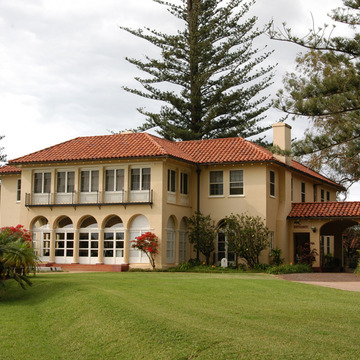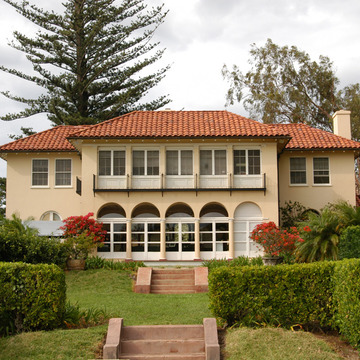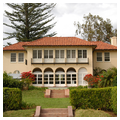You are here
Hui Noeau Visual Arts Center (Harry and Ethel Baldwin House, “Kaluanui”)
The imposing exterior formality of this stuccoed, two-story, Mediterranean-style villa conceals a surprisingly light and airy interior. Utilizing a pavilion plan, the house is entered through the porte-cochere off one of the wings. The former living room features round-arched French doors opening onto a small interior courtyard, while on the opposite wall, behind the fireplace, sits an enclosed lanai. Now a gallery, the lanai once featured a trellised ceiling which supported a vine growing from a fountain planter. Its arcade-like doorways overlook terraced, formal Italian gardens.
Harry Baldwin, a son of Henry Perrine Baldwin, was the vice president of Alexander and Baldwin, and manager of Maui Agricultural Company. As was common among the Islands' “Big Five” executives, he was also politically active, serving in the territorial Senate from 1913 to 1919. The Baldwins occupied this home until the 1950s. Since 1976, the house has operated as an art center under the management of Hui Noeau, a group of artists and artisans formed by Ethel Baldwin in 1934.
The lava-rock ruins with the nine-foot archway at the entrance of this 17.76-acre estate are the remains of the Kaluanui Plantation's sugar mill of 1857.
Writing Credits
If SAH Archipedia has been useful to you, please consider supporting it.
SAH Archipedia tells the story of the United States through its buildings, landscapes, and cities. This freely available resource empowers the public with authoritative knowledge that deepens their understanding and appreciation of the built environment. But the Society of Architectural Historians, which created SAH Archipedia with University of Virginia Press, needs your support to maintain the high-caliber research, writing, photography, cartography, editing, design, and programming that make SAH Archipedia a trusted online resource available to all who value the history of place, heritage tourism, and learning.





